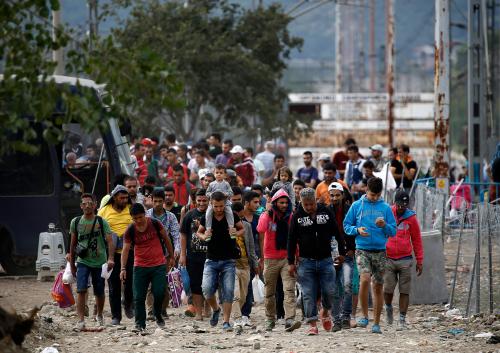In 2017, the U.N. refugee agency, UNHCR, estimated that globally 68.5 million people had been forcefully displaced—the worst such crisis since World War II. Of these, 40 million were internally displaced peoples (IDPs), 25.4 million were refugees, and 3.1 million were asylum seekers. Over half were minors and over half of those minors were out of school. In 2017, 61 percent of refugee children were in primary school, compared to 92 percent globally and 23 percent were in secondary school compared to 84 percent globally. Two-thirds of refugee children in primary school don’t go on to secondary education and only 1 percent go on to higher education.
These numbers are comparable (primary school) or worse (secondary) for Syrian refugees, who constitute the largest national group of refugees at 6.3 million. There are 3.5 million in Turkey, 1 million in Lebanon (the world’s highest per capita refugee population), and some 660,000 in Jordan. These are registered refugees; actual numbers may be higher. Jordan says it hosts 1.3 million Syrians, Lebanon cites estimates of 1.5 million. Smaller numbers are in Iraq (250,000) and Egypt (125,000).
Syrian refugees aged 5 through 18 in Jordan, Lebanon, and Turkey respectively number 240,000, 390,000, and 1,035,000. Children under 5 are respectively at 102,000, 154,000, and 535,000. In these neighboring countries of Syria, approximately 40 percent of 1.7 million school-aged refugee children are out of school—actual numbers may be higher. A situation that portends further social challenges for host countries and for Syria as refugees return.
Turkey has 610,000 Syrian children in formal education: 61 percent in public schools, the rest in Temporary Education Centers (TECs) where 13,000 Syrians teach a modified Syrian curriculum. To better integrate a population unlikely to go home soon, TECs are being phased out and children are transferring to Turkish public schools. There are fears that older children may drop out as they face classes in Turkish, while the fate of Syrian teachers in the TECs remains unclear. Despite extending Turkey’s Conditional Cash Transfer (CCT) program on education to refugees (230,000 receive payments) and hiring 3,600 Turkish language instructors, 42 percent of refugee children remain unschooled for socio-economic and other reasons. As with the CCT program supported by the EU, the U.S. and others, donors are engaged.
Lebanon has some 220,000 refugee children in school including 150,000 in double shifts in public schools. This leaves at least 170,000 or 44 percent out of school. The World Bank notes that only 10 percent of Syrian refugee children are in secondary school; the UNHCR says it is 5 percent. Secondary school classes are held in English and French, which presents a significant barrier. Still, Lebanon’s donor supported Reaching All Children with Education (RACE) program, focused on host communities and refugees, hopes to enroll 440,000 refugees in public schools by 2020-21. This is a commendable but monumental challenge.
In Jordan, some 131,000 refugee children aged 5 through 18 were in formal education at the end of 2017, the majority in double-shift schools. This still leaves at least 110,000, about 40 percent, outside of formal schooling. Tens of thousands of Syrian children are also in informal leaning programs. Jordan has a CCT program for Syrian children, but Jordan’s economic crisis has reduced recipients from 55,000 families to 10,000 in 2018. Here too multilateral institutions, the U.N. system, and others have been closely engaged in the sector.
In a telling statistic, UNICEF notes that 68 percent of Syrian children who are currently not in school in Jordan used to be in formal schooling—a situation attributed to economic imperatives, academic difficulties, and other reasons. This highlights the complexity of the schooling issue, underlining challenges beyond building more schools and making additional classes and teachers available—all necessary but not sufficient to bridge the schooling gap.
Poverty rates among refugees are high. In Jordan, 85 percent of registered Syrian refugee children live below the poverty line. In Lebanon, approximately 70 percent of Syrian refugees are below the poverty line while the annual Vulnerability Assessment of Syrian Refugees reveals that 58 percent of households are in extreme poverty. In Turkey, 67 percent of Syrian refugees live below the poverty line. Many children must work, others cannot afford supplies, transportation, etc.
Among key recommendations to deal with this challenge by KidsRights and others is livelihood support, including facilitating work permits and/or broader employment opportunities for adult refugees. Also proposed are establishing or expanding CCT programs as are allowing refugee teachers to teach, measures easing administrative bottlenecks for enrollment in schools, CCT programs, issuing IDs, etc. Language support in Turkey and Lebanon, providing safe transport, catch-up programs for the many children who have been out of school for years and measures against bullying and violence in schools are others. This is a whole-of-government challenge needing sustained international support with a role for the private sector and local and international NGOs.
The neighboring countries, especially Lebanon and Jordan with their much smaller populations, have shown amazing resilience. Yet, there is growing resentment in all countries as no imminent returns appear likely. Today’s 5 million or so registered refugees will nearly double over 20 years at an annual growth rate of 2.8 percent—a low estimate. As the world has learned since 2011, what happens in the Middle East does not necessarily stay there. All of us have a stake in ensuring that Syrian refugees do not become a ghettoized, persistent underclass with some prone to radicalization but return home to a peaceful Syria. In the interim, they must find asylum elsewhere in larger numbers and be better educated and therefore more self-sufficient and contributing positively to their host communities and to the world until then.
The Brookings Institution is committed to quality, independence, and impact.
We are supported by a diverse array of funders. In line with our values and policies, each Brookings publication represents the sole views of its author(s).









Commentary
Syrian refugees and the schooling challenge
October 23, 2018